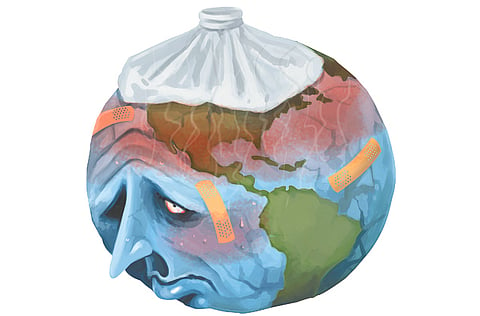Let’s open our eyes and save the house
At this critical point, when the fossil fuels that have brought us so much prosperity could lead to our demise, it is technological innovation that can steer us onto a better path

A crack in a house’s foundation, if not repaired, can continue to grow, ultimately destabilising the structure and rendering it uninhabitable. Its occupants must then move to another home. But the world’s population cannot move somewhere else. Houses, while not cheap, are replaceable; our planet is not.
Climate change, as we have known for years, is one such crack in the foundation. The Intergovernmental Panel on Climate Change (IPCC) has been studying the phenomenon since 1988. Twenty-two years ago, the United Nations Framework Convention on Climate Change (UNFCCC) was unveiled; today, 195 countries have agreed to prevent dangerous global warming by limiting the increase in global temperature to 2⁰C.
Yet we continue along our perilous path. The IPCC has calculated that we are hurtling toward temperature rises of 3.7⁰C to 4.8⁰C by the end of the century. The crack is widening, and some of the world’s inhabitants — particularly the most vulnerable — are already seeing the water seep in. Who is responsible, and who should pay to stop the warming?
These questions have dominated international discussion and debate about climate change from the start. Distinguishing between causal and remedial responsibility is crucial, and the UNFCCC’s chief document recognises common but differentiated responsibilities, as well as respective capabilities. As the sociologist Claus Offe recently pointed out, it is one thing to say who is to blame for the damage, and quite another to determine who can or should take responsibility for solving the problem.
This endless search for the true locus of responsibility (both causal and remedial) is not restricted to the realm of climate change. In a globalised world, for example, citizens of nation-states might wonder (as many have) why a financial crisis a hemisphere away causes their countries’ banks to collapse abruptly.
In Europe, where countries have banded together since the end of the Second World War, yielding some precious individual sovereignty in order to construct a more stable whole, the struggles of the common currency have instilled fear in citizens’ hearts — and in their votes. In the shift from government to governance, we have built a matrix of actors — private and public, at local, national, and supra-national levels — to address social and economic problems. But in this intricate and ever-changing institutional universe, we often no longer know who is in control.
This issue comes to the fore most frequently in the case of shared global problems, such as climate change. Simply put, the international order must be reformed and adapted to the economic rise of countries like India and China. The recent agreement among the Brics countries (Brazil, Russia, India, China and South Africa) to establish a New Development Bank and a contingent reserve arrangement is a clear signal of this thirst for change.
But a wholesale structural overhaul of the global economy’s institutional architecture is improbable, regardless of the context. In the interim, creativity is key. The best solutions are those that build on the current structure’s strongest points.
Top-down governance approaches have been useful, showing the willingness of some of the historical greenhouse-gas emitters to accept remedial responsibility. The European Union, for example, has affirmed its commitment to the UNFCCC’s Kyoto Protocol, the only international climate-change treaty to date to include binding emissions-reduction targets. But the most recent UNFCCC summits have revealed the limits of this approach.
So, as the world prepares for the UNFCCC summit in Paris in 2015, preceded by the high-level summit that UN Secretary-General Ban Ki-moon will convene in New York this September, it will be worthwhile to examine and export creative initiatives emerging from the bottom-up. China, for one, has launched seven pilot emissions-trading schemes, covering a quarter-billion people — the second-largest such effort in the world (after the EU). In Uganda, the city of Kampala is working to light its streets using solar power. Many small island states, such as Tuvalu, are setting an important example by rapidly pursuing the goal of carbon-neutrality.
One of the UNFCCC’s top priorities is to secure financing to scale up developing countries’ mitigation and adaptation efforts, thereby mobilising the capacity and goodwill of historical emitters to catalyse further innovation. Scientists worldwide are working on solutions; indeed, only science will help us to proceed effectively, just as it has enabled living standards in most of the world to rise above subsistence levels. At this critical point, when the fossil fuels that have brought us so much prosperity could lead to our demise, it is again technological innovation that can steer us onto a better path.
In the case of climate change, only creativity, innovation, responsibility, and political will can enable us to save our common house. We need to open our eyes, recognise the crack in the foundation, and face our responsibility to fix it. In the first quarter of 2015, governments should declare their countries’ intended contributions to that effort, thereby boosting confidence and accelerating progress en route to Paris. Meanwhile, we should be on the lookout for potential innovations and invest in research and development wherever that potential lies.
— Project Syndicate, 2014
Javier Solana was EU High Representative for Foreign and Security Policy, Secretary-General of Nato, and Foreign Minister of Spain. He is currently President of the ESADE Centre for Global Economy and Geopolitics and Distinguished Fellow at the Brookings Institution.
Sign up for the Daily Briefing
Get the latest news and updates straight to your inbox



